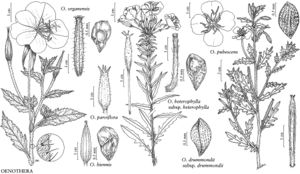Oenothera organensis
Genetics 23: 190. 1938.
Herbs perennial, moderately hirsute (hairs often with reddish purple, pustulate bases), alsostrigillose and becoming glandular puberulent distally; initially from slender taproot with single rosette, later developing numerous adventitious shoots from taproot and lateral roots, root system then appearing fibrous. Stems weakly erect to ascending, many from base, forming clumps 1–1.5 m diam., often branched distally, 30–60 cm. Leaves in a weakly developed basal rosette and cauline, basal 9–23 × 1–2.5 cm, cauline 5–11 × 1.5–3.5 cm; petiole 0.5–1.5 cm; blade very narrowly oblanceolate to narrowly elliptic, margins undulate, remotely and bluntly dentate. Flowers opening near sunset, not strongly scented; buds with free tips terminal, erect, 3–10 mm; floral tube straight, 100–165(–190) mm; sepals 25–50 mm; petals yellow, fading deep reddish orange, broadly obovate with truncate apex, or obcordate, 30–55 mm; filaments 18–35 mm, anthers 10–19 mm; style 140–235 mm, stigma exserted beyond anthers at anthesis. Capsules erect to slightly spreading at acute angle from stem, cylindrical, 25–35 ×4–5.5 mm, dehiscent at least 3/4 their length. Seeds numerous, in 2 distinct rows per locule, dark reddish brown, sometimes with darker flecks, obovoid, asymmetrical, irregularly angled, 1.5–2.1 × 1–1.2 mm, surface irregularly pitted and with collapsed papillae. 2n = 14.
Phenology: Flowering Jun–Sep.
Habitat: In larger rhyolite canyons, along water courses, in eroded basins filled with gravel and rocks.
Elevation: 1800–2300 m.
Discussion
Oenothera organensis is known only from the Organ Mountains, Doña Ana County, especially on the east side. Various studies have been done to assess the status of this narrow endemic and estimate 2000 to 5000 individuals with wide fluctuations likely due to variation in rainfall (W. Dietrich et al. 1985). Oenothera organensis could decline if degradation of habitat increases in the Organ Mountains. The genetics and population biology of this taxon have been heavily studied in the past (summarized in Dietrich et al.). It is self-incompatible.
Selected References
None.
